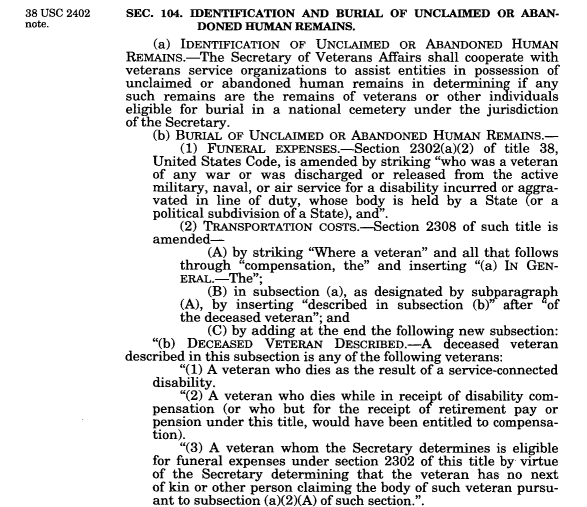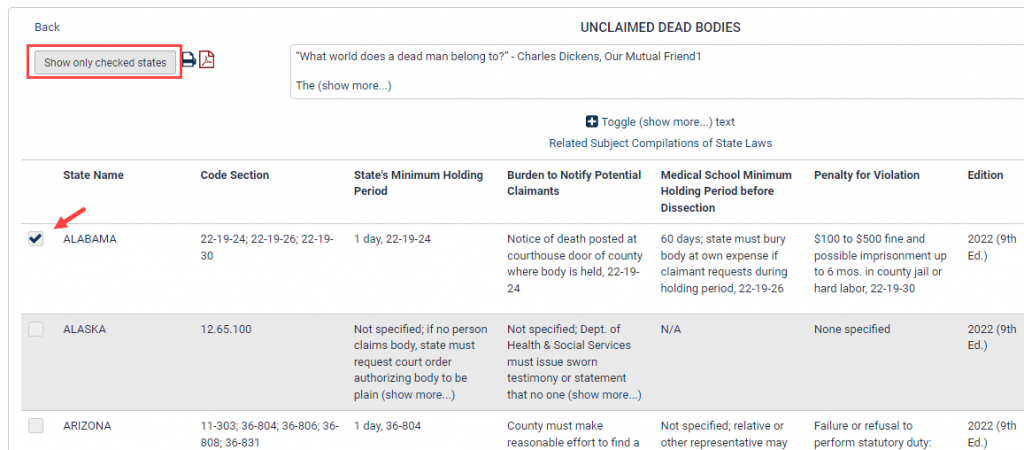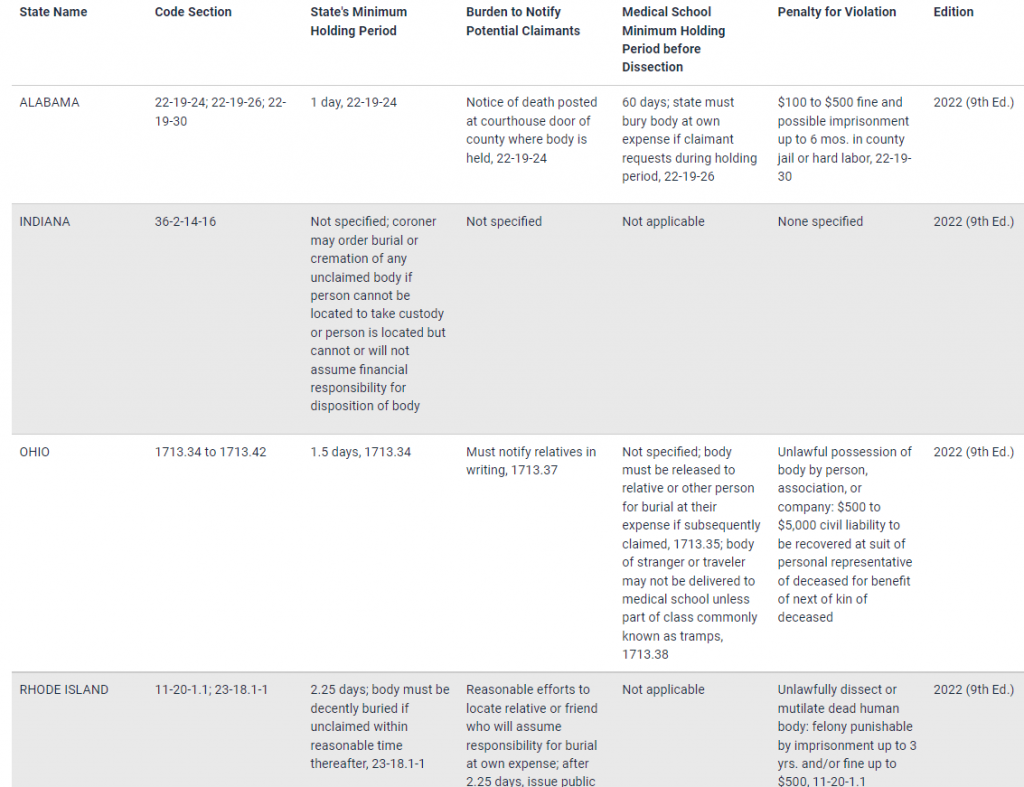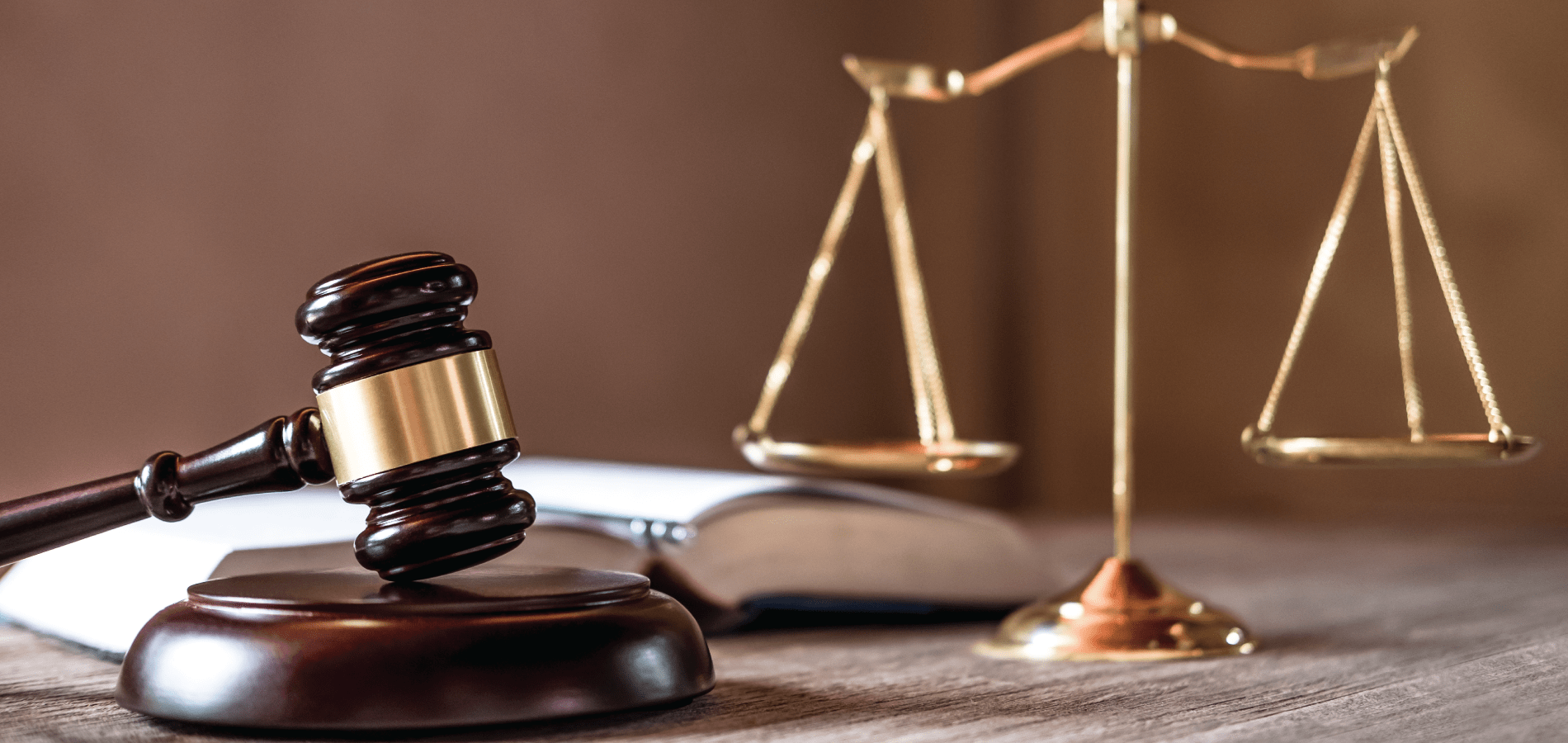If you’ve ever thought about your death, you’ve probably imagined your family and friends celebrating your life and remembering the good times. Maybe you’ll be buried in a cemetery next to a deceased relative, or cremated and kept as a reminder by those who love you. But that’s not the case for everyone. Some people go “unclaimed” and are left to the state. Each state law varies in the handling of unclaimed dead bodies. In fact, the only nationwide law that exists is for unclaimed veterans,[1]Dignified Burial and Other Veterans’ Benefits Improvement Act of 2012, Public Law 112-260, 112 Congress, 126 Stat. 2420 (2013). This document can be found in HeinOnline’s U.S. Statutes at Large database. as the Department of Veterans Affairs will arrange and pay for funeral and burial costs.

There are no official statistics about how many unclaimed dead bodies are buried in the United States, but the National Missing and Unidentified Persons System allows states to enter in their data. For example, using this tool we can see that there are more than 6,900 open cases of unclaimed persons in New York State alone.
Why Bodies Go Unclaimed
Unclaimed bodies differ from unidentified bodies, as the morgue knows who the person is, but they have not been claimed by friends or family. So why are so many bodies unclaimed? According to the National Funeral Directors Association, the average cost of a funeral in 2021 was more than $7,800. Often marginalized people do not claim their family members due to burden of cost.[2]Elizabeth Howell Boldt, Nail in the Coffin: Can Elderly Americans Afford to Die. 21 Elder L.J. 149 (2013). This article can be found in HeinOnline’s Law Journal Library. In fact, due to rising costs of funerals, in 1984 the Federal Trade Commission issued a Funeral Rule[3]Consumer Protection Mission, 1984 Annual Report of the Federal Trade Commission 8 (1984). this document can be found in HeinOnline’s U.S. Federal Agency Documents, Decisions, and Appeals database. allowing consumers to request prices over the phone or in writing prior to making funeral arrangements. Additionally, over the years unclaimed dead bodies have been on the rise due to the opioid crisis, the COVID-19 pandemic, natural disasters,[4]Traci McKee, Resurrecting the Rights of the Unclaimed Dead: A Case for Regulating the New Phenomenon of Cadaver Trafficking, 36 Stetson L. REV. 843 (2007). This article can be found in HeinOnline’s Law Journal Library. and homelessness.
A Grave Past
Scientific experimentation and unclaimed dead bodies have gone hand in hand for many years, and unfortunately disproportionately impact underprivileged communities. For instance, in the early 1800s, scientists displayed dissected Black women’s bodies[5]Drew H. Culler, The Invisible Dead, a Silent Epidemic: Violating the Right of Sepulcher through Scientific Experimentation and Mass Disposal of Unclaimed Human Remains, 7 Wake Forest J. L. & Pol’y 296 (2017). This article can be found in … Continue reading to show their flaws in relation to white women. What’s more, deceased Black slaves were sold to universities[6]Drew H. Culler, The Invisible Dead, a Silent Epidemic: Violating the Right of Sepulcher through Scientific Experimentation and Mass Disposal of Unclaimed Human Remains, 7 Wake Forest J. L. & Pol’y 296 (2017). This article can be found in … Continue reading for dissection. Thieves would locate unmarked graves, steal the bodies, and sell them on the black market or to medical centers. Due to a large public outcry over these grave robbers, laws to protect the dead were introduced.[7]Traci McKee, Resurrecting the Rights of the Unclaimed Dead: A Case for Regulating the New Phenomenon of Cadaver Trafficking Student Works, 36 Stetson L. Rev. 843 (2007). This article can be found in HeinOnline’s Law Journal Library.
So where does the law stand with unclaimed dead bodies today? In most states, unclaimed dead bodies are still used for medical research. Human cadavers are needed for research and medical training,[8]Traci McKee, Resurrecting the Rights of the Unclaimed Dead: A Case for Regulating the New Phenomenon of Cadaver Trafficking, 36 Stetson L. REV. 867 (2007). This article can be found in HeinOnline’s Law Journal Library. and with a shortage of bodies being donated, institutions rely on unclaimed bodies. In New York State, however, unclaimed bodies cannot be used as a cadaver without consent from the spouse, next of kin, or an organ donation registration. Within the city, the Department of Corrections pays their inmates to bury the unclaimed dead.[9]Mary L. Clark, Keep Your Hands Off My (Dead) Body: A Critique of the Ways in Which the State Disrupts the Personhood Interests of the Deceased and His or Her Kin in Disposing of the Dead and Assigning Identity in Death, 58 Rutgers L. Rev. 70 (2005). … Continue reading What’s the law in other states? Let’s use HeinOnline to find out.
Digging Up the Facts
This Halloween, shock your friends with your ghastly knowledge of unclaimed dead bodies with the help of your ghoulfriends at HeinOnline.
National Survey of State Laws
HeinOnline has a few different resources for researching the law of unclaimed dead bodies across the United States. In fact, we have a dedicated resource for this exact topic! National Survey of State Laws is a print and online resource that provides an overall view of some of the most asked-about and controversial legal topics in the United States. Presented in an interactive chart format, NSSL allows users to make basic state-by-state comparisons of current state laws. And, we just added the most recent laws for 2022 with the new 9th edition!
From the database homepage, locate the Unclaimed Dead Bodies topic from the alphabetical listing. Then select the states you want to compare. For example, let’s take a look at Alabama, Indiana, Ohio, and Rhode Island. Simply check the boxes next to these four states and select “Show only checked states.”

A new chart appears only displaying the selected states. From here, we can easily compare the differences between the states.
For example, in Alabama, a notice of death has to be posted at the courthouse door of the county where the body is held, but in Ohio, the relatives must be notified in writing. We can see that Indiana lacks any specific laws, other than leaving the burden of the burial or cremation on the coroner. In addition, the body of a stranger may not be delivered to a medical school unless the person is known as homeless in Ohio. In Alabama, a medical school must hold on to the body for 60 days prior to dissection.

Session Laws Library
HeinOnline also contains the Session Laws Library, the only complete online source of laws from all 50 states, beginning with territorial, colonial, and early statehood laws and continuing through to today. Let’s run a search for “unclaimed dead bodies” across all of the state session laws. Then, let’s refine the search to Alabama and sort the results by oldest first to see if the law has changed over time.

We can see from the first result dating back to 1923, the penalty for violation is the same as what’s listed in the 9th edition (2022) of National Survey of State Laws. The fine for violating the unclaimed dead body law is no less than $100 and no more than $500 and can include jail or hard labor.

Don’t Hit a Dead End
Need help constructing searches or navigating specific databases? We have a plethora of help resources available! Be sure to check out our ever-growing list of LibGuides, our fully searchable Knowledge Base, and short helpful videos on our YouTube Channel.
HeinOnline Sources[+]
| ↑1 | Dignified Burial and Other Veterans’ Benefits Improvement Act of 2012, Public Law 112-260, 112 Congress, 126 Stat. 2420 (2013). This document can be found in HeinOnline’s U.S. Statutes at Large database. |
|---|---|
| ↑2 | Elizabeth Howell Boldt, Nail in the Coffin: Can Elderly Americans Afford to Die. 21 Elder L.J. 149 (2013). This article can be found in HeinOnline’s Law Journal Library. |
| ↑3 | Consumer Protection Mission, 1984 Annual Report of the Federal Trade Commission 8 (1984). this document can be found in HeinOnline’s U.S. Federal Agency Documents, Decisions, and Appeals database. |
| ↑4 | Traci McKee, Resurrecting the Rights of the Unclaimed Dead: A Case for Regulating the New Phenomenon of Cadaver Trafficking, 36 Stetson L. REV. 843 (2007). This article can be found in HeinOnline’s Law Journal Library. |
| ↑5 | Drew H. Culler, The Invisible Dead, a Silent Epidemic: Violating the Right of Sepulcher through Scientific Experimentation and Mass Disposal of Unclaimed Human Remains, 7 Wake Forest J. L. & Pol’y 296 (2017). This article can be found in HeinOnline’s Law Journal Library. |
| ↑6 | Drew H. Culler, The Invisible Dead, a Silent Epidemic: Violating the Right of Sepulcher through Scientific Experimentation and Mass Disposal of Unclaimed Human Remains, 7 Wake Forest J. L. & Pol’y 296 (2017). This article can be found in HeinOnline’s Law Journal Library. |
| ↑7 | Traci McKee, Resurrecting the Rights of the Unclaimed Dead: A Case for Regulating the New Phenomenon of Cadaver Trafficking Student Works, 36 Stetson L. Rev. 843 (2007). This article can be found in HeinOnline’s Law Journal Library. |
| ↑8 | Traci McKee, Resurrecting the Rights of the Unclaimed Dead: A Case for Regulating the New Phenomenon of Cadaver Trafficking, 36 Stetson L. REV. 867 (2007). This article can be found in HeinOnline’s Law Journal Library. |
| ↑9 | Mary L. Clark, Keep Your Hands Off My (Dead) Body: A Critique of the Ways in Which the State Disrupts the Personhood Interests of the Deceased and His or Her Kin in Disposing of the Dead and Assigning Identity in Death, 58 Rutgers L. Rev. 70 (2005). This article can be found in HeinOnline’s Law Journal Library. |



